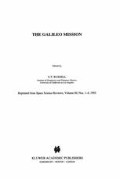Abstract
The Galileo spacecraft was launched by the Space Shuttle Atlantis on October 18, 1989. A two-stage Inertial Upper Stage propelled Galileo out of Earth parking orbit to begin its 6-year interplanetary transfer to Jupiter. Galileo has already received two gravity assists: from Venus on February 10, 1990 and from Earth on December 8, 1990. After a second gravity-assist flyby of Earth on December 8, 1992, Galileo will have achieved the energy necessary to reach Jupiter. Galileo's interplanetary trajectory includes a close flyby of asteroid 951-Gaspra on October 29, 1991, and, depending on propellant availability and other factors, there may be a second asteroid flyby of 243-Ida on August 28, 1993. Upon arrival at Jupiter on December 7, 1995, the Galileo Orbiter will relay data back to Earth from an atmospheric Probe which is released five months earlier. For about 75 min, data is transmitted to the Orbiter from the Probe as it descends on a parachute to a pressure depth of 20-30 bars in the Jovian atmosphere. Shortly after the end of Probe relay, the Orbiter ignites its rocket motor to insert into orbit about Jupiter. The orbital phase of the mission, referred to as the satellite tour, lasts nearly two years, during which time Galileo will complete 10 orbits about Jupiter. On each of these orbits, there will be a close encounter with one of the three outermost Galilean satellites (Europa, Ganymede, and Callisto). The gravity assist from each satellite is designed to target the spacecraft to the next encounter with minimal expenditure of propellant. The nominal mission is scheduled to end in October 1997 when the Orbiter enters Jupiter’s magnetotail.
Access this chapter
Tax calculation will be finalised at checkout
Purchases are for personal use only
Preview
Unable to display preview. Download preview PDF.
Abbreviations
- ASI:
-
Atmospheric Structure Instrument
- EPI:
-
Energetic Particles Instrument
- HGA:
-
High Gain Antenna
- IUS:
-
Inertial Upper Stage
- JOI:
-
Jupiter Orbit Insertion
- JPL:
-
Jet Propulsion Laboratory
- LRD:
-
Lightning and Radio Emissions Detector
- NASA:
-
National Aeronautics and Space Administration
- NEP:
-
Nephelometer
- NIMS:
-
Near-Infrared Mapping Spectrometer
- ODM:
-
Orbit Deflection Maneuver
- OTM:
-
Orbit Trim Maneuver
- PJR:
-
Perijove Raise Maneuver
- PM:
-
Propellant Margin
- PDT:
-
Pacific Daylight Time
- PST:
-
Pacific Standard Time
- RPM:
-
Retropropulsion Module
- RRA:
-
Radio Relay Antenna
- SSI:
-
Solid State Imaging
- TCM:
-
Trajectory Correction Maneuver
- UTC:
-
Universal Time Coordinated
- UVS:
-
Ultraviolet Spectrometer
- VEEGA:
-
Venus-Earth-Earth Gravity Assist
References
Byrnes, D. V., D’Amario, L. A., and Diehl, R. E.: 1987, Galileo Options After Challenger, AAS Paper 87–420, presented at the AAS/AIAA Astrodynamics Specialist Conference, Kalispell, Montana, August 1987.
D’Amario, L. A., Byrnes, D. V., Johannesen, J. R., and Nolan, B. G.: 1987, Galileo 1989 VEEGA Trajectory Design, AAS Paper 87–421, presented at the AAS/AIAA Astrodynamics Specialist Conference, Kalispell, Montana, August 1987.
D’Amario, L. A., Bright, L. E., Byrnes, D. V., Johannesen, J. R., and Ludwinski, J. M.: 1989, Galileo 1989 VEEGA Mission Description, AAS Paper 89–431, presented at the AAS/AIAA Astrodynamics Specialist Conference, Stowe, Vermont, August 1989.
Johannesen, J. R., Nolan, B. G., Byrnes, D. V., and D’Amario, L. A.: 1987, Asteroid/Comet Encounter Opportunities for the Galileo VEEGA Mission, ASS Paper 87–422, presented at the AAS/AIAA Astro-dynamics Specialist Conference, Kalispell, Montana, August 1987.
Maize, E. H.: 1989, Earth Flyby Delivery Strategies for the Galileo Mission, AAS Paper 89–427, presented at the AAS/AIAA Astrodynamics Specialist Conference, Stowe, Vermont, August 1989.
Mitchell, R. T.: 1988, Galileo Earth Avoidance Study Report, JPL Internal Document D-5580, Revision A (Galileo Project Document 1625–396, Revision A), 4 November, 1988.
O’Neil, W. J.: 1990, Project Galileo, paper presented at the AIAA Space Programs and Technologies Conference, Huntsville, Alabama, September 25–27, 1990.
Yeates, C. M., Johnson, T. V., and Young, R.: 1992, ‘Galileo Mission Overview’, Space Sci. Rev. 60, 3 (this issue).
Author information
Authors and Affiliations
Editor information
Editors and Affiliations
Rights and permissions
Copyright information
© 1992 Springer Science+Business Media Dordrecht
About this chapter
Cite this chapter
D’Amario, L.A., Bright, L.E., Wolf, A.A. (1992). Galileo Trajectory Design. In: Russell, C.T. (eds) The Galileo Mission. Springer, Dordrecht. https://doi.org/10.1007/978-94-011-2512-3_2
Download citation
DOI: https://doi.org/10.1007/978-94-011-2512-3_2
Publisher Name: Springer, Dordrecht
Print ISBN: 978-94-010-5108-8
Online ISBN: 978-94-011-2512-3
eBook Packages: Springer Book Archive

